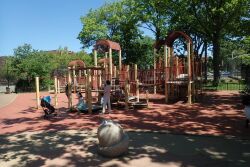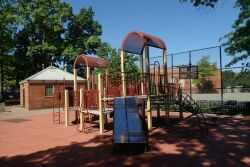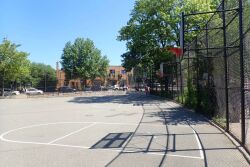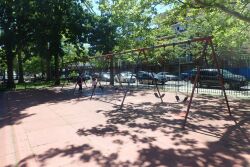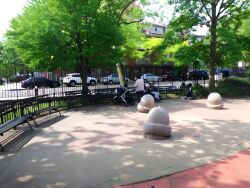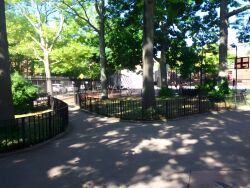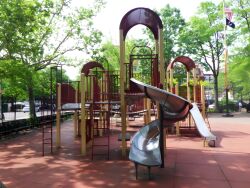Colden Playground
Cadwallader Colden Playground
Located at the intersection of Union Street and 31st Road, this playground takes its name from nearby Public School 214, the Cadwallader Colden School, which is named for the famous physician, scientist, and statesman of colonial New York. Cadwallader Colden (1688-1776) was born in Ireland in 1688, while his mother was visiting Ireland, and was raised in Duns, Scotland. His father was a Presbyterian minister, and Colden followed his father's footsteps and enrolled at the University of Edinburgh, intending to become a minister. Young Cadwallader soon became interested in the sciences, however, and drifted away from the ministry. He graduated from Edinburgh with an A.B. in 1705, and traveled to London to study medicine.
In 1710, Colden immigrated to the colony of Pennsylvania, settling in Philadelphia. There he became both a doctor and a merchant. Promised a position by Robert Hunter (d. 1734), the colonial Governor of New York, Colden came to New York City in 1718. Two years later, he was appointed Master in Chancery and Surveyor General of New York. In 1721, Governor William Burnett (1688-1729) appointed Colden to the Governor's Council, an advisory board consisting of the elite members of society. Several years later, Colden published a famous work on the Iroquois, The History of the Five Indian Nations Depending on the Province of New York (1727).
For nearly 15 years, Colden was one of the most powerful men in New York. Between 1760 and 1775, he served intermittently as president of the Governor's Council, Lieutenant Governor, and acting Governor. Yet, in his dealings with the colonists, Colden remained politically naïve. In 1760, he raised their ire by declaring that colonial judges served at "the pleasure of the king" rather than, by colonial custom, "on good behavior." A year later, Colden impulsively moved to restrain trade between New York and the French West Indies, a decision that met with protests. The most glaring example of Colden's political ineptitude came four years later, during the Stamp Act Crisis of 1765. In the face of mounting opposition to the Stamp Act, a British revenue measure that required a stamp to be affixed to all articles of paper, Colden stood firm behind the British. In October 1765, a New York City mob hanged him in effigy and burned his coach and sleigh. Forced to capitulate to public pressure, Colden returned the stamps to Britain. He continued to serve as acting Governor, but events soon surpassed his ability to control them. The American Revolutionary War broke out in 1775, forcing him out of his governorship. In September 1776, one month after the Battle of Brooklyn (also known as the Battle of Long Island), Colden died on his Long Island estate, Spring Hill.
A better scientist than he was a statesman, Colden was a pioneer in several fields. His scientific interests included biology, botany, chemistry, physics, and astronomy. As a physician, he studied cancer, yellow fever, smallpox, and the effect of climate on disease. Upon learning the Linnaean system of classifying flora and fauna, he completed a classification of local species, which was published by the inventor of the Linnaean system, Carolus Linnaeus (1707-1778), in 1749. In 1751, Colden published a critique of the famous work by Sir Isaac Newton (1642-1727), Philosophiae Naturalis Principia Mathematica (1687). Colden's critique was titled The Principles of Action in Matter.
In March 1951, Parks acquired this property for use as a public park and playground. Three years later, the playground opened as P.S. 214 Playground, jointly operated by Parks and the Board of Education. In 1986, Commissioner Stern changed the name to Union Street Playground. One year later, he changed the park's name again, to Cadwallader Colden Playground.
In 2001, the playground underwent a $1.2 million renovation, funded by City
Council Member Julia Harrison. The baseball diamond, basketball court, and playground
areas were repaved, and new modular play equipment, swings, a spray shower,
and fencing were installed. Trees, shrubs, and ground cover were planted, and
decorative oak leaf and animal art features were introduced.
Check out your park's Vital Signs
Clean & Safe
Green & Resilient
Empowered & Engaged Users
Share your feedback or learn more about how this park is part of a
Vital Park System

